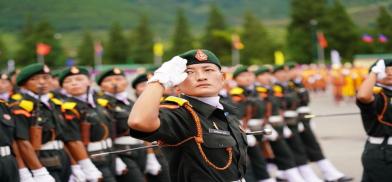Will China have its way in Bhutan?
The question is whether Bhutan can ward off the Chinese pressure, given the dynamics of South Asia, chances of which don’t appear bright.

It has been more than two decades when PLA soldiers periodically came to the Royal Bhutan Army (RBA) post in the Doklam Plateau, stayed put for few hours and told the RBA to get out claiming it as Chinese territory. These incidents were never reported in Bhutanese or Indian media. China desperately wants Doklam Plateau since it overlooks the PLA garrisons in Chumbi valley.
The Doklam Plateau is the private property of Bhutan’s royal family, not government property. India had the opportunity for decades to negotiate with Bhutan’s royals to explore the feasibility of establishing a joint India-Bhutan project in Doklam. This would have been a deterrent to the Chinese. A Delhi-based think tank even suggested this in writing to the external affair ministry more than a decade back. But initiative is not the forte of our diplomats when it has anything to do with China.
The more than two-month long India-China standoff at Doklam ending on August 28, 2017 was covered well in the media. But China continued to build a full-fledged military complex thereafter just 81 meters from the Indian post (https://www.ndtv.com/india-news/full-fledged-chinese-military-complex-in-doklam-show-satellite-pics-1801323).
China has established dual-use militarized modular villages on Bhutan’s territory, which according to US scholars also have air defense and electronic warfare elements. Bhutan has denied their existence – same as India denies Chinese villages in Arunachal Pradesh built during the current standoff with China.
Three-step roadmap
In October 2021, China and Bhutan signed the MoU for a three-step roadmap to expedite the boundary negotiations; Mao Zedong’s dictum of entire Bhutan being part of China could wait. China’s claim to Bhutan’s Sakteng sanctuary (adjacent to Arunachal Pradesh) in 2020, China-Bhutan MoU for the three-step roadmap to resolve the boundary, and increased PLA intrusions in Arunachal all happened while the India-China border standoff is still continuing. These actions are interlinked.
Agreements reached during the 13th Expert Group Meeting (EGM) on Bhutan-China Boundary Issues held in August 2023 in Beijing included: maintaining momentum of the talks and holding the 14th EGM earliest; establish Joint Technical Team on Delimitation of Bhutan-China Boundary, and; maintaining communication to hold the 25th round of Bhutan-China Boundary Talks. Initially India was part of China-Bhutan border negotiation but direct China-Bhutan dialogue was established in 1984
The 13th EGM was third in the series within 2023. Notably, the Joint Technical Team on Delimitation of Bhutan-China Boundary held its first meeting on the sidelines of the 13th EGM itself, which indicates formation of the joint technical team was taken before the 13th EGM (probable at or after the 12th EGM) but was kept under wraps.
It is evident that China is pulling out all stops, taking advantage of the India-China standoff. Bhutan would be apprehensive of China’s muscle-flexing on its territory looking at India's timid response to Chinese intrusions in Ladakh and efforts to cover up the ground situation.
Chinese moves
China could activate the Line of Actual Control with India in case India moves to assist Bhutan militarily. Besides, India has itself lit the fires in Manipur which are unlikely to die down soon. In the most recent incidents of killings and arson in Manipur on August 31, mortar shelling and drones were used. China would be a fool not to exploit the situation.
Acquiring the long-sought Doklam Plateau would enable China to deploy PLA troops on the Jhampari Ridge overlooking the Siliguri Corridor, also bringing it within PLA artillery range. It would also turn the flanks of Indian deployments in East Sikkim. This would pose a serious security threat to India from yet another direction. The US-led West may actually be happy with such a development; perceiving this would make India lean more towards them.
India is aware of the Chinese moves in Bhutan and has now deployed central armed police forces to guard the sensitive Siliguri Corridor. The pressure on Bhutan would be immense to cede the Doklam Plateau to China. China would also be promising economic development and rail-road connection to Bhutan from the north, given its demonstrated prowess in infrastructure development along the Himalayas. India is yet to connect Bhutan with a rail link.
The question is whether Bhutan can ward off the Chinese pressure, given the dynamics of South Asia, chances of which don’t appear bright. Besides, Bhutan would not want its territory to become an arena of military confrontation and conflict. So, will China have its way in Bhutan?
The author is an Indian Army veteran. Views expressed are personal.
Our company delivers custom solutions for companies of any capacity.
We manage all logistics processes to make your workflow seamless.
<a href="https://asia-cargo.site/">air freight costs from china</a>
With scheduled shipments, we ensure timely delivery of your orders.
Clients trust our skilled team and competitive rates.
Choosing us means confidence in every delivery.
Больницы всё чаще оборудуются высокотехнологичную технику.
Это позволяет специалистам ставить быстрые диагнозы.
Актуальные приборы обеспечивают комфорт и для больных, и для медиков.
https://dangtinvantai.com/threads/kakie-imenno-medcentry-vy-sovetuete-v-stolice.68098/
Развитие высоких технологий ускоряет эффективное восстановление.
Большинство устройства содержат функции для глубокого наблюдения состояния здоровья.
Врачи могут своевременно реагировать, основываясь на данных аппаратуры.
Таким образом, инновационное медоборудование усиливает эффективность лечебного процесса.
Here, you can explore various materials that expand knowledge.
Visitors will value the materials shared through this platform.
All topics is organized clearly, making it comfortable to use.
The articles are easy to understand.
The site includes tips on different subjects.
Whether you’re looking for practical advice, this site has a lot to offer.
Overall, this platform is a reliable place for curious minds.
https://rublevo.info/










Post a Comment